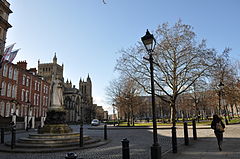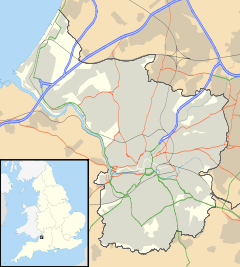- College Green, Bristol
-
Coordinates: 51°27′09″N 2°36′05″W / 51.4526°N 2.6015°W
College Green
College Green showing Queen Victoria statue, Cathedral and Council House
 College Green shown within Bristol
College Green shown within BristolOS grid reference ST584727 List of places: UK • England • Bristol College Green is a public open space in Bristol, England. The Green takes the form of a segment of a circle with its apex pointing east, and covers 1.1 hectares (2.7 acres). The road named College Green forms the north-eastern boundary of the Green, the Cathedral marks the south side, and the Council House closes the Green in an arc to the north-west.
College Green is owned by the Dean and Chapter of Bristol Cathedral, and managed by Bristol City Council.
Contents
History
Originally a small hill north of the River Avon separated from Brandon Hill to the north west by a narrow gully, College Green was enclosed to form the precincts of St Augustine's Abbey (now Bristol Cathedral) in the 12th century. After the Dissolution of the Monasteries, the abbey became a collegiate church and its precincts thenceforth became known as 'College Green'.[1]
The Bristol High Cross was moved here from its original location at the junction of High St, Wine St, Broad St and Corn St, where it had been considered a traffic hazard, in 1733. In 1762 the Green was levelled and laid out as a raised park with stone boundary walls, railings and formal promenades crossing at its centre. The High Cross was relegated to a corner of the Green, and in 1768 it was given to Henry Hoare for use as a garden ornament at Stourhead, where it can still be seen.[2]
The name 'College Green' also applied to the road which passed on either side of the Green. The southern leg of this formed part of the main route out of Bristol heading to the south-west and separated the Green from the Cathedral, whilst the north-eastern leg led towards Clifton. In 1850 a replica of the High Cross was erected and placed at the apex of the Green. This remained here until a statue of Queen Victoria took its place in 1888, at which time the Cross was moved to the centre of the Green, at the intersection of the formal promenades. For the next sixty years the Green remained a leafy oasis, insulated from the busy roads on either side by tall trees,[3] though slightly diminished by the removal of the outer row of trees on the north-eastern side for road-widening in 1926.[4]
In 1950 at the request of Vincent Harris, controversial architect of the Council House,[5] all remaining trees, the formal promenades, statue and High Cross were removed and the Green lowered to street level. Harris stated that this "would 'make' my building", and considered the removal of the statue and High Cross "a minor detail".[6] Wide new promenades were laid out running parallel to the sides of the Green, with low Portland stone borders.
After a period of storage at Redcliffe Wharf during which other locations were considered, and following a campaign for its return,[7] the statue of Queen Victoria was returned to the apex on the Green in 1953. Part of the replica High Cross, vandalised in storage, is now preserved in Berkeley Square.
In 1991 the southern perimeter road was closed to through traffic and grassed over for much of its length, uniting the Cathedral with its Green.[8] The eastern end was retained to give access to buildings to the east of the Cathedral, re-laid with reclaimed setts. As part of this enhancement scheme, a circular seating area was laid out near the apex and reclaimed cast-iron lamp posts were installed.
Sites of Interest
College Green is surrounded by a number of historic and important public buildings, including the Council House, the Lord Mayor's Chapel, the Cathedral and the Abbey Gatehouse.
Queen Victoria's statue stands at the apex of the Green, and in the south-western corner near the Central Library is a statue of social reformer Raja Rammohun Roy.
Events
College Green is a popular meeting place for young people, particularly street sports enthusiasts.[9] This has led to tensions, and in 2007 a Group Dispersal Order was served on the area to allow the police to prevent groups of young people congregating.[10]
With its proximity to the Council House, College Green is often the focus of protests against local or national government policy.[11][12] On 15 October 2011, it became the site for Occupy Bristol, a camp established as part of the worldwide "Occupy" protests against social and economic inequality.[13][14]
College Green is a regular venue for media launches, press calls, charity fundraisers and product launches [15]
There are plans to place a 50m high observation wheel on College Green in summer 2011.[16]
Gallery
-
Statue of Ram Mohan Roy
See also
References
- ^ Little, Brian (1991). The Story of Bristol. Redcliffe Press. ISBN 1-872971-40-7.
- ^ "The Old City - The High Cross". About Bristol. http://www.about-bristol.co.uk/old-04.asp. Retrieved 2011-03-13.
- ^ Winstone, Reece (1978). Bristol As It Was 1939-1914. Reece Winstone. pp. 10–15. ISBN 0-900814-54-3.
- ^ Winstone, Reece (1972). Bristol as it Was 1914-1900. Reece Winstone. p. 20. ISBN 0-900814-41-1.
- ^ "A tall order to pick Bristol's best buildings for veteran architect Mike Jenner". Bristol Evening Post. http://www.thisisbristol.co.uk/news/TALL-ORDER-PICK-CITY-S-BEST-BUILDINGS/article-2796466-detail/article.html. Retrieved 18 Feb 2011.
- ^ Winstone, Reece (1980). Bristol as it Was 1950-1953 (3rd Edition). Reece Winstone. p. 24. ISBN 0-900814-60-3.
- ^ Winstone, Reece (1980). Bristol as it Was 1950-1953 (3rd Edition). Reece Winstone. p. 60. ISBN 0-900814-60-3.
- ^ College Green Pedestrianisation - Experimental Colsure of College Green to Through Traffic:- Effective from Sunday, 2nd June 1991, Leaflet, Avon County Council and Bristol City Council, 1991
- ^ http://www.yelp.co.uk/biz/college-green-bristol
- ^ http://www.kerrymccarthymp.org/news.aspx?i_PageID=10978
- ^ http://www.thisisbristol.co.uk/news/Protests-public-services/article-2336836-detail/article.html
- ^ http://www.thisisbristol.co.uk/news/Bristol-residents-protest-bus-service-cut-council-s-doorstep/article-1958682-detail/article.html
- ^ "Occupy Bristol activists set up camp". The Guardian. 2011-10-17. http://www.guardian.co.uk/world/2011/oct/17/occupy-bristol-activists-camp. Retrieved 2011-10-31.
- ^ "Demonstrators set up camp on College Green". Bristol Evening Post. 2011-10-18. http://www.thisisbristol.co.uk/Demonstrators-set-camp-College-Green/story-13588943-detail/story.html. Retrieved 2011-10-31.
- ^ http://www.bristol.gov.uk/ccm/content/Environment-Planning/Parks-and-open-spaces/parks/college-green.en;jsessionid=EF921BC69885CA489E17697AF66CA35A.tcwwwaplaws3
- ^ http://www.thisisbristol.co.uk/news/THEBRISTOLEYE/article-2617953-detail/article.html
- Andrew Foyle, Bristol, Pevsner Architectural Guides (2004) ISBN 0-300-10442-1
External links
Categories:- Parks and open spaces in Bristol
- Squares in Bristol
Wikimedia Foundation. 2010.










